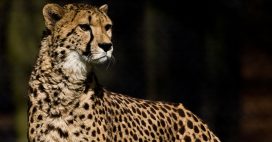Russia

Russia is the largest country in the world, with more than 6.5 million square miles (over 17 million square km). With a wide array of habitats, which include polar deserts, Tundra, Forest tundra, Mixed and Broad-leafed forests, forest steppe, steppe, semi-desert and subtropic. As a result of this, its wildlife varies greatly.
In the west, it is a true European habitat, and this country contains 30,000-40,000 wolves, and 120,000 brown bears. It is also an important place for polar bears, though these are threatened as with the rest of their range.
The only home of the Amur leopard and the Amur tiger lies in the far east of Russia (both species also live in small areas in China – while both have been near extinction in the last few decades, they are rebounding (though compared to their historic range, their recovery has barely started, and time will tell if the are allowed).
Amur Leopard status: It is hard to count such a secretive animal, however in 2022, 125 adult Amur leopards were identified in Russia and 46 in China in 2019 – given the number is growing, it seems reasonable to suggest the total population is around 150-175. Given the whole population was 30-40 in 2001, this has been a remarkable turn around, though the species is still far from full recovery.
Amur Tiger status: The Amur tiger is thought to have a wild population 265-485. Like the Amur leopard, they have had to recover dramatically, though this recovery has happened over a longer time frame. The Amur tiger is thought to have had a wild population of 50 back in the 1940s. Going back to 1850 there was thought to be around 1000 Amur tigers, however uncontrolled hunting brought this number down until they were threatened with extinction. Another thing to remember, is that recent analysis has shown that the Caspian tiger was merely the western-most population of the Amur tiger, so there is also the possibility of translocating Amur tigers to a variety of sites further west, however, the population needs to grow more before this happens.
The Causican (Asia Minor) Leopard also hangs on though in small numbers – though given this animals total population is around 1100, few of these will live in Russia.
Snow Leopards are also found, with an estimated population of 150-200 within the country. Indeed the range of wildlife of this country is quite incredible
Links to areas to visit will appear below.
Help us build up a map of where wildlife has been seen. Add any sightings of mammals that you encounter. As this map starts to be used, we will greatly reduce how long sightings remain free for anyone to see, so that hunters and poachers cannot use this as a resource. The idea is that over time we can build up an idea of exactly where we should look for them. Researchers and similar feel free to add your sightings, We have a members area of the website where full maps will be available, and we are willing to give free memberships to reseachers working on populations that live in the wild










